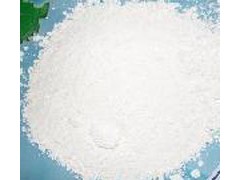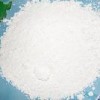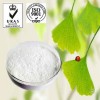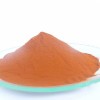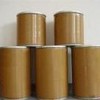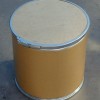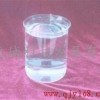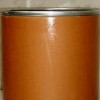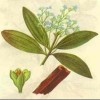Caffeic acid
Caffeic acid is a hydroxycinnamic acid, a naturally occurring organic compound. This yellow solid consists of both phenolic and acrylic functional groups. It is found in all plants because it is a key intermediate in the biosynthesis of lignin, one of the principal sources of biomass.
Occurrence and biological function
Caffeic acid, which is unrelated to caffeine, is biosynthesized by hydroxylation of coumaroyl ester of quinic ester. This hydroxylation produces the caffeic acid ester of shikimic acid, which converts to chlorogenic acid. It is the precursor to ferulic acid, coniferyl alcohol, and sinapyl alcohol, all of which are significant building blocks in lignin.[2] The transformation to ferulic acid is catalyzed by the enzyme caffeic acid-O-methyltransferase.
Caffeic acid and its derivative caffeic acid phenethyl ester (also known as CAPE, molecular formula : C17H16O4,molar mass :284.30654 g/mol, exact mass : 284.104859) are produced in many kinds of plants.
In traditional and alternative medicine
Caffeic acid has been shown to inhibit carcinogenesis, although other experiments show possible carcinogenic effects. It is also known as an antioxidant in vitro and also in vivo.[5] Caffeic acid also shows immunomodulatory and antiinflammtory activity.
Caffeic acid outperformed the other antioxidants, reducing aflatoxin production by more than 95 percent. The studies are the first to show that oxidative stress that would otherwise trigger or enhance Aspergillus flavus aflatoxin production can be stymied by caffeic acid. This opens the door to using natural anti-fungicide methods by supplementing trees with antioxidants.[6]
Oral administration of high doses of caffeic acid in rats has caused stomach papillomas, leading to the perception of caffeic acid as carcinogenic. In the same study, only high doses of combined antioxidants, including caffeic acid, showed a significant decrease in growth of colon tumors in those same rats. No significant effect was noted otherwise.[7]
Caffeic acid is still listed under older Hazard Data sheets[8] as a potential carcinogen because of two early experiments on rats and mice. More recent data show that bacteria in the rats' guts may alter the formation of metabolites of caffeic acid.[9][10] There have been no known ill-effects of caffeic acid in humans.
Caffeic acid and its derivative, Caffeic acid phenethyl ester (CAPE) have shown tumor-shrinking properties. When an anti-cancer drug was being sought, caffeic acid and CAPE were derived from Burning Bush (Euonymus alatus). "The subcutaneous and oral administrations of CA and CAPE significantly reduced liver metastasis. These results confirm the therapeutic potential of the compounds and suggest that the anti-metastatic and anti-tumor effects of CA and CAPE are mediated through the selective suppression of MMP-9 enzyme activity and transcriptional down-regulation by the dual inhibition of NF-κB as well as MMP-9 catalytic activity." [11] A study using the caffeic acid phenethyl ester (CAPE) showed a positive effect on reducing carcinogenic incidence. Caffeic acid phenethyl ester (CAPE) is an active component of propolis from honeybee hives.[12] It is known to have antimitogenic, anticarcinogenic, anti-inflammatory, and immunomodulatory properties.[13]
Another study also showed that CAPE suppresses acute immune and inflammatory responses and holds promise for therapeutic uses to reduce inflammation.[14]
This anti-inflammatory and anti-cancer property has also been shown to protect skin cells when exposed to ultraviolet (UV) radiation, in particular UVC radiation[15] and UVB radiation.[16] This anti-cancer effect was also seen when mice skin was treated with bee propolis and exposed to TPA (a chemical) that induced skin papillomas. CAPE significantly reduced the number of papillomas.[17][18] Caffeic acid and chlorogenic acid from coffee beans both reduced DNA methylation in vitro in two lines of human cancer cells. DNA methylation contributes to the growth of tumors and regulates the epigenetics of cells that are passed along with DNA to future generations.[19]
Caffeic acid has been shown to be an inhibitor of the lipoxygenase enzyme that forms leukotrienes from arachidonic acid. This function has been useful in scientific experiments to elucidate the roles of the leukotrienes in various inflammatory responses
Caffeic acid may be the active ingredient in caffenol, a do-it-yourself black-and-white photographic developer made from instant coffee.[21] The developing chemistry is similar to that of Catechol or Pyrogallol.[22]
It is also used as a matrix in MALDI mass spectrometry analyses.[23]
1) Best quality and competitive price
2) Professional delivery service

